The John Bankston Collection
2nd Marine Division, 8th Marines
First American troops to enter Kyushu, Japan
September 1945
Photos by: Corp. Frank C. Rodgers, Combat Photographer, 2nd Marine Division,
8th Marines
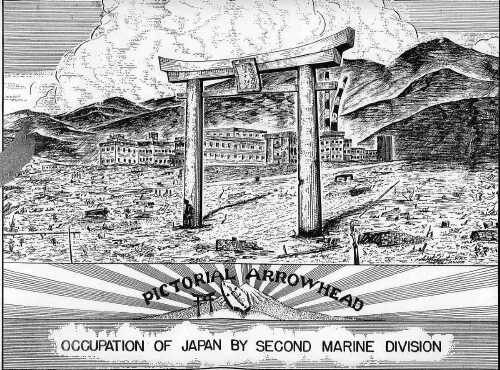
Click on image for page 1 of Pictorial Arrowhead
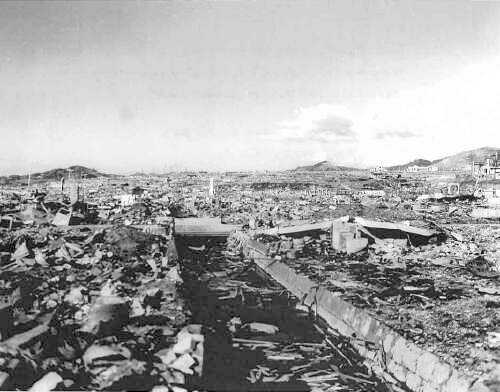
The center of Urakami, 4 miles north of Nagasaki, looking NE from Nagasaki.
This is what the A-bomb left.

The largest Catholic church on Kyushu Island, Urakami Cathedral,
completed in 1925 after 30 years of work, 6,000 seating capacity,
10,000 of the 15,000 parishioners died in the blast.
It is about 500 meters NE of the hypocenter.
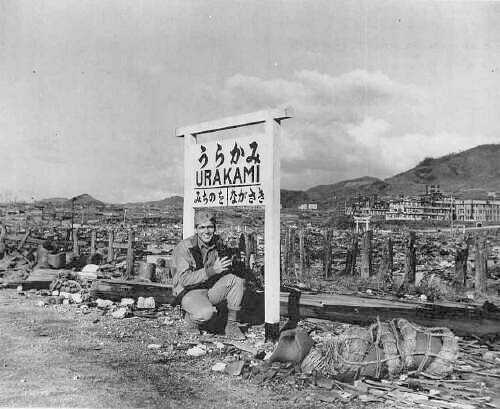
Picture of Frank C. Rodgers.
He said in one article that he was older than most 18
and 19 year olds he was with; later worked as a journalist.
Urakami once stood here. It is 4 miles from Nagasaki.
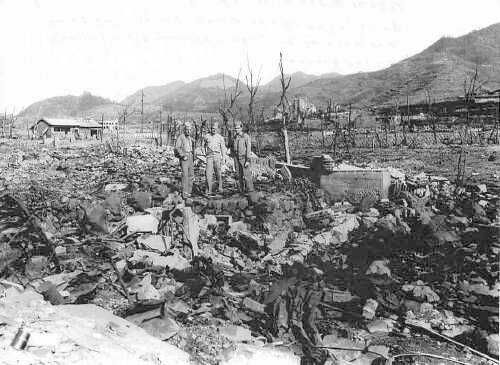
Naval Base and College grounds completely destroyed by the bomb,
splintering trees and burning all frame houses and buildings to the ground.
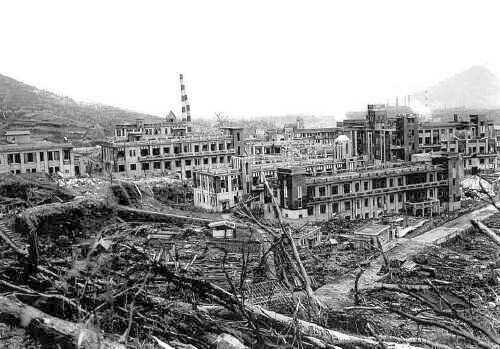
Japanese Naval and Hospital College near ground zero.
Everything wooden inside the buildings was totally incinerated to nothing.
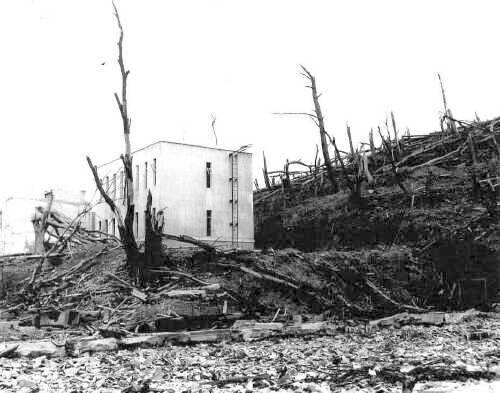
The only buildings left after the bomb were concrete ones.
Caves in side of hill were used for storage and air raid shelter.
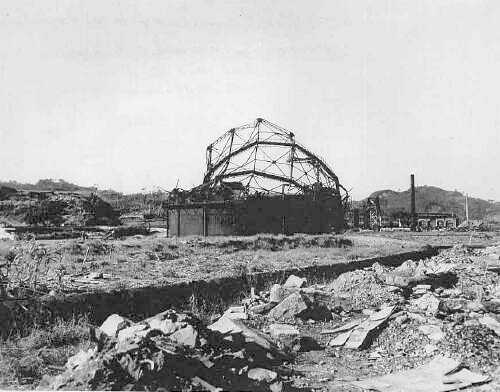
Gas tanks 5 miles north of ground zero.
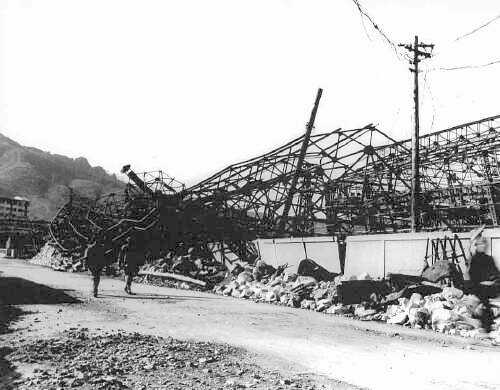
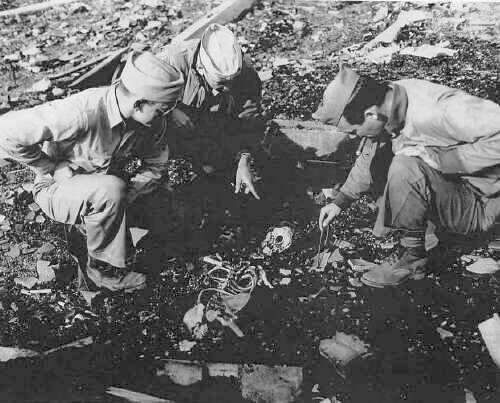
Japanese skeleton found near ground zero of atomic bomb area.
It was nothing more than pulverized ash.

Japanese school boy receiving first aid for cuts and bruises from the atomic
bomb blast. He was attending school 12 miles from ground zero.The school's
windows were shattered from the blast.

Kagoshima, Japan 10/45
East section of city firebombed by B-29's. Natural volcano in background.
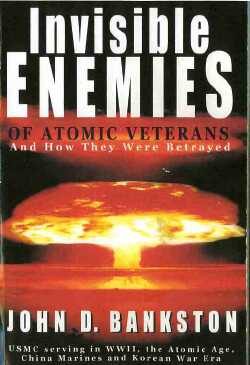
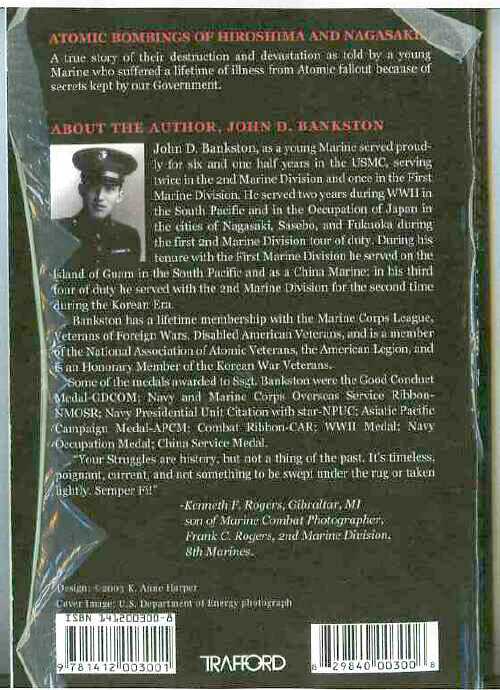
John D. Bankston, as a young Marine served proudly for six and one half years
in the USMC, serving twice in the 2nd Marine Division and once in the First
Marine Division. He served two years during WWII in the South Pacific and
in the Occupation of Japan in the cities of Nagasaki, Sasebo, and Fukuoka
during the first 2nd Marine Division tour of duty. During his tenure with
the First Marine Division he served on the island of Guam in the South Pacific
and as a China Marine; in his third tour of duty he served with the 2nd Marine
Division for the second time during the Korean Era.
Bankston has a lifetime membership with the Marine Corps League, Veterans
of Foreign Wars, Disabled American Veterans, and is a member of the National
Association of Atomic Veterans, the American Legion, and is an Honorary Member
of the Korean War Veterans.
Some of the medals awarded to Ssgt. Bankston were the Good Conduct Medal-GDCOM;
Navy and Marine Corps Overseas Service Ribbon-NMOSR; Navy Presidential Unit
Citation with star-NPUC; Asiatic Pacific Campaign Medal-APCM; Combat Ribbon-CAR;
WWII Medal; Navy Occupation Medal; China Service Medal.
"Your Struggles are history, but not a thing of the past. It's timeless,
poignanat, current, and not something to be swept under the rug or taken
lightly. Semper Fi!"
-- Kenneth F. Rogers, son of Frank M. Rogers Combat photographer WWII
The Beginning of the New Atomic Age
By John D. Bankston
It was during the invasion of Okinawa where our Task Force Planners evidently
had done highly strategic planning, and undoubtedly made wise decisions.
In fact, some of these decisions were made near the end of World War II,
when we were in battle with Japan.
As in all battles, there is loss of life in these tragic events. On this
particular day, at dawn, a Regimental observation post was established on
Okinawa’s east shoulder of Mezado Ridge. Mezado was a high and rugged
hill that was crowned by coral boulders. From this vantage point a person
could look south to the sea, and view most of the remaining Japanese terrain.
It was from this point that the Regimental Commander, Colonel Wallace, and
his operations officer, Major Chamberlin, were watching the Eighth Regimental
Combat Team, the Pictorial Arrowhead Second Marine Division Offensive down
below, battling its way to the city of Ibaru. Shortly after noon, a soldier
with an obviously large stature went up and joined them. That big soldier
was the Commander of the US Tenth Army and of the Okinawa Offensive. He was
Lieutenant General Simon Bolivar Buckner. General Buckner sat in a cleft
of rock and looked out over the Eighth Marine zone of action. He remained
for about an hour and remarked, “Things are going so well here I think
I’ll move on to another unit.” These were almost his last words.
Whether the Japanese, through their powerful long-range glasses, had somehow
discerned his presence, will probably never be known. Nonetheless, with a
suddenness of a clap of thunder, five Japanese artillery shells struck directly
on the observation post. They were large, probably 15CM shells, and they
blasted the coral heads and the men between them. Colonel Wallace and Major
Chamberlin escaped injury, almost miraculously. But General Simon Boliver
Buckner sank mortally wounded to the dusty rock, his glazing eyes looking
out toward the sea where, in only a few days’ time, he would have seen
victory for his troops.
The death of General Buckner in the Eighth Marines observation post was only
one of two dramatic casualties of an 18 June date. To describe the second,
one needs to briefly envision a ‘flashback’ on the 18th day of
June 1944 when the Third Battalion, Eighth Marines, also was engaged with
the Japanese enemy on the island of Saipan. On that day, Corporal Bennie
E. Rash of Kentucky was moving forward at the side of Corporal Grover Wells
when Japanese fire cut down Corporal Wells. Three months later Wells’
brother, Earl, joined the Eighth Regiment and, by startling coincidence,
was placed in the same squad 18 June 1945 on Okinawa. Two Marines moved
cautiously around the dangerous boulders and ledges of Kunishi Ridge. There
was a burst of Japanese fire, and Earl H. Wells fell dead, at the feet of
Corporal Rash. So died two brothers, doing the same job—in the same
unit on the same day and in the company of the same mutual friend, exactly
one year apart.
In another instance a notable accidental meeting of
“Brothers-at-Arms” occurred on Okinawa. These brothers were Pfc.
Frank C. Rogers and Cpl. William B. Rogers. William had been overseas 12
months and was a member of a weapons company in the Sixth Marines. Frank
had been in combat nine months with the Eighth Regiment, Second Marine Division,
serving as a Combat Photographer. The brothers’ last meeting was after
William had joined the Marine Corps three and a half months earlier. When
Frank entered the Corps in September 1943 he realized his chance of meeting
his brother was a slim one. This made the Okinawa reunion a “natural”
as far as the two happy brothers were concerned. Two other Rogers’s
brothers also entered the service of their country, one making the supreme
sacrifice. He was Pfc. Paul Rogers, Jr., US Army, killed in the Philippines.
The other brother is Pfc. Stephen S. Rogers USMC who was wounded during the
Guam, MI battle. As noted in a Detroit, Michigan [US] newspaper, Frank Rogers,
the Combat Photographer, was admired for his courage as he served in the
conflict and by his skill in combat photography. Frank was assigned to the
Eighth Marine Regiment during the bitter fighting in southern Okinawa. The
Detroit Marine remained on the front lines throughout the final phases of
the campaign, recording on film the deeds of his fellow Marines. It was during
this time that Rogers laid aside his camera long enough to account for seven
Japanese soldiers with his rifle. This same fellow Marine made an official
photograph of General Buckner and his observation crew just seconds before
the fatal mortar rounds hit the observation post. Frank’s son, Kenneth
F. Rogers, verified this fact and told of Frank being “knocked flat
by the blast which fatally wounded Lieutenant General Simon B. Buckner and
took the last pictures of the Tenth Army Commander and of the Okinawa
offensive.”
After a few weeks into the operation of Okinawa and since there were no other
islands in the South Pacific with any significance left to invade, it became
incumbent upon the Task Force Generals that the vast fleet afloat in the
East China Sea and around Okinawa was in great danger of being destroyed.
The Japanese leaders knew unquestionably the preponderance of the hundreds
of ships in this fleet and would be willing to use many of the amassed kamikazes
stored back in their homeland to attack them. The fleet, fully loaded with
combat gear and troops, was definitely vulnerable and our leaders made a
wise decision in sending the ships with troops back to their original locations
so they would be available for Operation Olympia had it occurred.
When the two Atomic bombs, “Little Boy,” (a Uranium bomb), and
“Fatman,” (a Plutonium bomb), were dropped on Hiroshima August
6 and August 9, 1945, respectively, devastating these two industrial cities,
by and large caused Japan to surrender unconditionally on September 2, 1945.
The wise decision to send the ships from the Okinawa area back to their original
location paid off in a different way than planned. Instead of using the ships
and troops for Operation Olympia to invade Japan’s mainland, many were
used in the occupational duties of Japan after it had been ravaged by these
deadly Atomic bombs. The dangers of radiation and radioactivity had been
known in the late 1800s, when some say the Atomic Age actually began. With
the difference in the magnitude of atomic forces today compared to the 1800s,
would it not be correct to say that we are living in ‘The Beginning
of the New Atomic Age?” The New Atomic Age started immediately after
the destruction of Hiroshima and Nagasaki by the Atomic bombs, “Little
Boy” and “Fatman.” This factual evidence should be enough
to prove that the two gigantic explosions entered us into “The New Atomic
Age.”
Not only did we enter a new era, those two historical bombings on August
6 and August 9, 1945 might be said to have changed the whole world. In every
aspect the physical damage to the Japanese people that was caused by these
two A-bombs was astronomical. An absolute major change began when the B-29
pilot tilted the wings of the Enola Gay after dropping its first atomic bomb
on Hiroshima to permit its crews to review the results that “Little
Boy” obtained. The second Atomic bomb that destroyed one-third of Nagasaki
might be said to have sealed the world’s transformation “in
concrete.”
As soon as we were able to disembark, my first area to visit was the Mitsubishi
Factory in the one-third part of Nagasaki that was destroyed. I noticed a
wrench on what appeared to be a machinist’s bench, as I was telling
my Comrade, Moe, from Akron, Ohio, we called that kind of wrench a monkey
wrench back on the farm. With bare hands I attempted to pick it up, only
to find it was welded to the machinist’s bench from the intense heat.
Several of us left the Mitsubishi Factory and traveled into what was known
as the “Valley of Death.” As sad and grievously oppressive as it
was to the eye and mind, the valley was appropriately named because it was
profoundly clear that no one or any living species escaped this sea of
destruction in any form less than invisible micro bits. Both sides of the
mountains surrounding the valley were unbelievably disintegrated and scorched
from the bottom of the valley to the tops of the peaks. The one third of
Nagasaki that was completely devastated created enough vivid imagination
to last a lifetime. With amazement we continued viewing the fragmented debris
throughout the valley in sizes from micro dust particles, and debris of
square-inch pieces and less. What appeared to be foundations of buildings,
including burnt leaning frames in different directions, made a good reference
point where the blast occurred. “Fat Man” was believed to have
exploded 1800 feet above ground zero near the Nagasaki Prison known as
“Prison Hill.”
The first atomic bomb tested at Trinity testing grounds in Almorgordo, New
Mexico did not cause a chain reaction, as Scientists thought highly possible.
However, it did cause an arms race for other countries searching for the
formula that started numerous nuclear experimental Test Shots. In doing so
the thousands of Atomic, Nuclear Thermal, Hydrogen, Atmospheric and subtest
shots during the Cold War Race caused grave worldwide damage to our entire
ecosystem and millions of human lives. The shattering horrific and egregious
damage has caused severe suffering, destruction, and early deaths to our
“Atomic Veterans” and families while using “Super Secrets”
by White House Officials. Several major departmental level agents have completely
cut us off in communicating with the general public to plead our case for
justice. Some questions that “Atomic Veterans” would like answers
to are: Will we ever regain our Constitutional Rights that were trampled
on? Should the four words on the Supreme Court Building, “Equal Justice
For All,” be removed? There are many more unresolved issues regarding
atomic radiation, veterans who were directly affected, and thousands of others
who suffered from fallout. These questions have been asked for almost sixty
years by veterans who were intentionally made to suffer by our own Government
when they secretly used “human experimentation” for the purpose
of studying long-term effects of exposure to ionizing radiation. There was
no valid reason for our government’s actions—or inaction in this
case. Additionally, most physicians have not been willing to discuss the
effects that radiation has had on those exposed to it because they wanted
to avoid the complex paperwork trail, which nullified proper treatment that
should have been administered to us. Could the foolish moves by our leaders
be akin to marching those valued troops into an enemy prison camp, begging
them to torture us? To a man, we showed nothing but respect for our leaders
and truly believed in their trustworthiness toward us.
Volumes of pages have been written about the disastrous effects that radiation
has done to the hundreds of thousands, if not millions, of servicemen and
civilians. Families of those who gave their lives, along with the survivors,
are still suffering by degrees from the radiation that was released in those
powerful bombs. The untold secrets kept by our own Government about the dangers
of radiation exposure in this new age are surfacing some 60 years later and
the legacy of this suffering must continue until justice is served.
It was over nine months after our initial Occupational Duties began in Japan
that our Unit was given orders to report to Sasebo and embark aboard the
USS Kershaw APA 176 on July 7, 1946 to begin our journey back home. We sailed
there from on July 8, 1946. A large number of girl friends and friends in
general that we made during our stay in their country were on the docks to
wish us Bon Voyage and Sayonara. As far as we could see before the horizon
blocked our view it seemed as if no one had moved from the docks and that
their thoughts were sailing with us. We were proud to be a small part of
the history that was made while occupying Japan and equally as proud to be
sailing home.
I would be remiss if I did not tell one other incident in particular that
WWII generated; however, it did not come to fruition until 56 years later
and that happened because of the invention of our modern means of
telecommunications. Norm Sorensen, a Crew Member aboard the USS Kershaw 176
that transported our Unit home after the big war and Occupational Duties
in Japan, was browsing the Internet and saw the link about my book,
“Invisible Enemies of Atomic Veterans.” Norm purchased a copy and
read where I had mentioned the name of the ship. We then E-mailed each other
several times indicating how amazing it was that we met each other in this
manner. Our Internet meeting occurred shortly before the National WWII Memorial
Dedication Ceremony in Washington D.C. on Saturday, May 29, 2004. Norm was
an Appointee of Governor Schwarzenegger of California and some members of
his staff were coming to the Dedication Celebration to represent Governor
Schwarzenegger and Norm invited me to join them. I readily accepted Norm’s
invitation and we agreed on a place to meet. He said he would meet me at
the front entrance of the MCI Center, where we would be viewing the ceremonies,
and would be holding a copy of my book so that I would recognize him. Because
of the extremely heavy traffic that day I was a few minutes late arriving,
so Norm asked his grandson to take his place waiting for me. I was some distance
away when I spotted a young man with the bright red and burnt orange front
cover held in the air for all to see. It was an honor to get the special
invitation to the WWII Memorial Dedication ceremony, as well as to meet
Norm’s lovely wife, Patricia, their daughter and grandson. The Historical
event itself was very impressive, although it was 57 years late in coming,
but joining Norm and his family in such a coincidental way made the Memorial
Dedication even more meaningful.
A short while after the WWII Memorial Dedication, I received an E-mail from
Patricia informing us of Norm’s sudden demise. From the brief time we
spent together it was obvious that the two of them were very close and we
join Pat in her great loss. May Norm Rest in Peace.
Other links: U.S.
Atomic Veterans - John Bankston
(Atomic Veterans History
Project - stories from those who witnessed atomic and hydrogen weapons
tests, with over 500 photos from declassified DOE atomic test films *THIS WEBSITE GONE?*). See also the Radiated Veterans website. The Bomb Project has more related info and links. Also here and here.
|